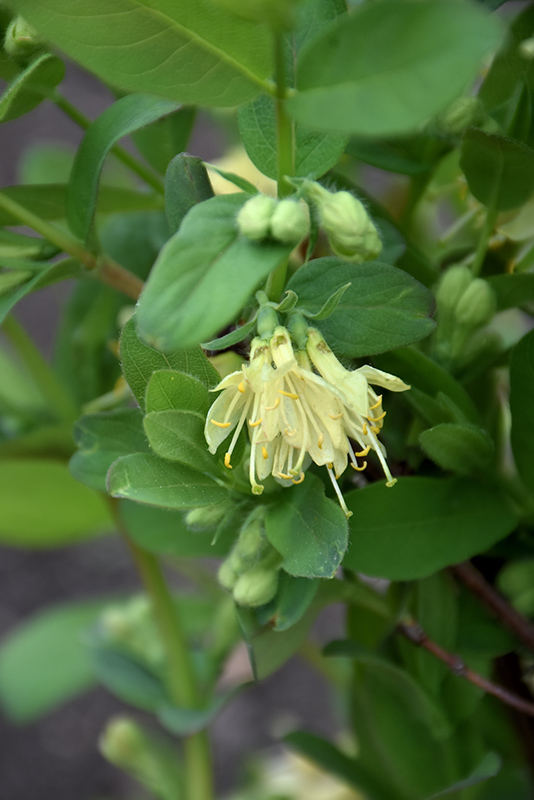Honeybee® Honeyberry
Lonicera caerulea 'Honeybee'
Height: 6 feet
Spread: 5 feet
Sunlight:
![]()
![]()
Hardiness Zone: 2
Other Names: Honey Bee, Sweetberry Honeysuckle, Haskap
Description:
A fast growing, hardy shrub with clean foliage and delicious, bluish-purple edible berries in early summer; medium sized with a bushy habit; selected for larger fruit and high yields, must have another honeyberry variety for cross pollination
Edible Qualities
Honeybee® Honeyberry is a medium-sized shrub that is commonly grown for its edible qualities, although it does have ornamental merits as well. It produces large deep purple round berries with powder blue overtones which are usually ready for picking in early summer. The berries have a sweet taste and a fleshy texture.
The berries are most often used in the following ways:
- Fresh Eating
- Preserves
- Juice-Making
- Wine-Making
Features & Attributes
Honeybee® Honeyberry features subtle buttery yellow flowers along the branches from late winter to early spring. It has green deciduous foliage. The narrow leaves do not develop any appreciable fall color. It features an abundance of magnificent deep purple berries with powder blue overtones from late spring to early summer.
This is a dense multi-stemmed deciduous shrub with a more or less rounded form. Its average texture blends into the landscape, but can be balanced by one or two finer or coarser trees or shrubs for an effective composition. This plant will require occasional maintenance and upkeep, and is best pruned in late winter once the threat of extreme cold has passed. It is a good choice for attracting butterflies to your yard. It has no significant negative characteristics.
Aside from its primary use as an edible, Honeybee® Honeyberry is sutiable for the following landscape applications;
- Mass Planting
- Hedges/Screening
- General Garden Use
- Orchard/Edible Landscaping
Planting & Growing
Honeybee® Honeyberry will grow to be about 6 feet tall at maturity, with a spread of 5 feet. It tends to fill out right to the ground and therefore doesn't necessarily require facer plants in front, and is suitable for planting under power lines. It grows at a medium rate, and under ideal conditions can be expected to live for approximately 20 years. While it is considered to be somewhat self-pollinating, it tends to set heavier quantities of fruit with a different variety of the same species growing nearby.
This shrub is quite ornamental as well as edible, and is as much at home in a landscape or flower garden as it is in a designated edibles garden. It does best in full sun to partial shade. It prefers dry to average moisture levels with very well-drained soil, and will often die in standing water. It is not particular as to soil type or pH. It is highly tolerant of urban pollution and will even thrive in inner city environments. This is a selected variety of a species not originally from North America.
What Our Clients & Customers Say
Let’s Get Started
Family-owned and operated since 1995
Our 2 Montana garden center locations, Butte and Belgrade & Bozeman areas, provide you with quality and experience.
Wagner Nursery & Landscaping Co. Belgrade, MT
Wagner Nursery, Belgrade
220 Kendall Ct, Belgrade, MT 59714, USA
(406) 388-2559
Hours: Mon-Sat 9am to 5pm
Wagner Nursery & Landscaping Co. Butte, MT
Wagner Nursery, Butte
33 Holliday Dr, Butte, MT 59701, USA
(406) 782-5855
Hours: Mon - Fri 9am to 5:00pm
Saturdays: 9am to 3pm

